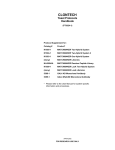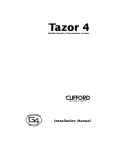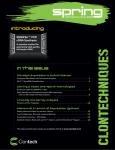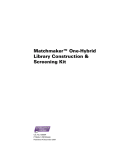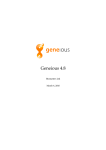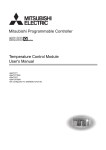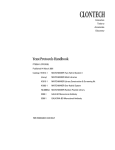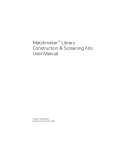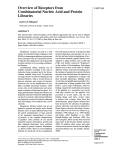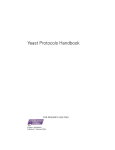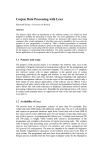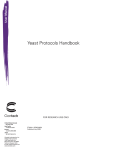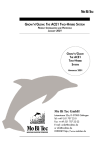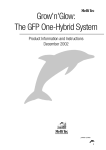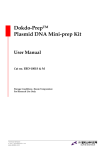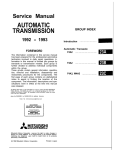Download DupLEX-A YEAST TWO
Transcript
TM DupLEX-A YEAST TWO-HYBRID SYSTEM User’s Manual Version 1.2 1/97 OriGene Technologies, Inc. 13 Taft Court, Suite 111 Rockville, MD 20850 1-888-267-4436 FAX: 301-340-9254 2 DupLEX-A Yeast Two-Hybrid System Index I. Introduction II. List of components, additional materials required III. Recipes for media and solutions IV. Library information V. Checking and storing yeast strains VI. Screening libraries VII. Appendix I. Introduction The DupLEX-A™ system is a LexA-based version of the yeast two-hybrid system originally developed by Fields and Song. The yeast two-hybrid system has proven to be a powerful tool for identifying proteins from an expression library which can interact with one’s protein of interest. The DupLEX-A™ system was developed as a more versatile and more accurate version of the yeast two-hybrid system. The two-hybrid system of Fields and Song exploits the fact that a yeast transcriptional activator protein, Gal4p, has a separable DNA binding domain and activation domain; neither domain can activate transcription on its own. Transcriptional activation is detected only when the binding domain is bound to its DNA recognition sequence and is also tethered to the activation domain. The two-hybrid system involves fusing the Gal4p binding domain with a protein “X” and the Gal4p activation domain with a protein “Y”. If “X” and “Y” interact, then a functional Gal4p is restored and transcriptional activation can be detected. If binding sites for Gal4p are placed upstream of a reporter gene (such as lacZ), transcriptional activation can be monitored easily. The DupLEX-A™ system utilizes the same basic idea except that the DNA binding protein is the E. coli LexA protein while the activation protein is the acid blob domain B42. Neither LexA protein bound upstream of a reporter gene nor B42 alone can activate 3 transcription of the reporter, but if brought together via fusions with two interacting proteins, reporter gene expression can be detected. Advantages of the DupLEX-A™ system over other yeast two-hybrid systems include: 1. reduction in the number of false positives obtained since prokaryotic (LexA and B42) rather than eukaryotic (Gal4p) proteins are used 2. ability to screen potentially toxic target proteins since their expression is galactose-inducible 3. ability to demonstrate a potential positive’s interaction with bait is dependent upon expression of the potential positive 4. ease of doing a coimmunoprecipitation assay of bait and potential positive since antibodies to HA tag (fused downstream of B42) are available (if antibody to the bait protein is also available) 5. reporters with varying sensitivities are available so that baits which activate transcription on their own can potentially still be assayed simply by using a less sensitive reporter 6. ease of determining whether or not a particular bait protein will enter the yeast nucleus and bind LexA operators II. List of components, additional materials required A. LIST OF COMPONENTS NOTE: You will not need all of the components listed below. Read the manual carefully to determine which components will best suit your needs. Yeast strains EGY48 EGY194 EGY188 EGY40 MATα trp1 his3 ura3 leu2::6 LexAop-LEU2 (high sensitivity) MATα trp1 his3 ura3 leu2::4 LexAop-LEU2 (medium sensitivity) MATα trp1 his3 ura3 leu2::2 LexAop-LEU2 (low sensitivity) MATα trp1 his3 ura3 leu2::0 LexAop-LEU2 (negative control) 4 MATa trp1∆::hisG his3∆200 ura3-52 lys2∆201 leu2-3 (mating strain) RFY206 Streak on YPD plates and grow at 30oC for 2-3 days; start cultures from single colonies. Reporter gene (lacZ) plasmids (2 µ g each) pSH18-34 pJK103 pRB1840 pJK101 URA3, 2 µm, ApR , 8 ops.-lacZ (high sensitivity) URA3, 2 µm, ApR , 2 ops.-lacZ (medium sensitivity) URA3, 2 µm, ApR , 1 op.-lacZ (low sensitivity) URA3, 2 µm, ApR , GAL1-2 ops.-lacZ (used in repression assay) Bait plasmids pEG202 HIS3, 2 µm, ApR (constitutive ADH promoter expresses LexA and is followed by a polylinker for making the bait fusion protein); 10 µg pEG202-NLS HIS3, 2 µm, ApR (similar to pEG202 but with SV40 nuclear localization sequence between LexA and polylinker); 2 µg HIS3, 2 µm, ApR (similar to pEG202 except that the LexA sequence is 3´ rather than 5´ of the polylinker); 2 µg pNLexA Target plasmid pJG4-5 TRP1, 2 µm, ApR (inducible GAL1 promoter expresses B42-HA tag and is followed by a polylinker for making target fusion protein expression libraries from cDNA); 10 µg Control plasmids (2 µ g each) pRHFM1 HIS3, 2 µm, ApR (ADH promoter expresses LexA-homeodomain of bicoid fusion; used as a positive control in the repression assay and a negative control in the DupLEX-A™ screen) 5 pSH17-4 HIS3, 2 µm, ApR (ADH promoter expresses LexA-GAL4 activation domain; used as a positive control in the DupLEX-A™ screen) pEG202-Max expresses LexA-Max fusion constitutively; used as a negative control when testing isolated target proteins or as a positive control in the repression assay pBait constitutively expresses a LexA-bait fusion protein that interacts with the fusion protein from pTarget (see below); can also be used as a negative control when testing isolated target proteins or as a positive control in the repression assay) pTarget expresses (galactose-dependently) a B42-target fusion protein that interacts with the fusion protein from pBait (see above) Primers (10 µ g each) [Note: The concentration of each oligo is approximately 80 µM.] 5’ bait fusion primer: 5’-CGT CAG CAG AGC TTC ACC-3’ (used to determine the sequence of the junction between LexA and the bait) 5’ target fusion primer: 5’-CTG AGT GGA GAT GCC TCC-3’ (used to determine the reading frame and identity of positive clones; also, can be used with 3’ target primer to amplify clone by PCR) 3’ target fusion primer: 5’-GCC GAC AAC CTT GAT TG-3’ (used to determine the identity of positive clones; also, can be used with 5’ target primer to amplify clone by PCR) Other pJG4-6 TRP1, 2 µm, ApR (similar to pJG4-5 but without B42 activation domain; used to express an isolated target protein in yeast); 10 µg sonicated salmon sperm DNA, 5 mg/ml (prepared specially for yeast transformation); 10 mg total [CARRIER DNA] E. coli strain KC8 DupLEX-A™ System Manual 6 B. ADDITIONAL MATERIALS REQUIRED (not supplied) Note: The specific materials listed below are the ones we have tested in the DupLEX-A™ system. Similar items from other sources may be interchangeable. 1. 2. Yeast growth media vendor catalog # peptone agar yeast extract yeast nitrogen base w/o amino acids raffinose dextrose (glucose) galactose (glucose-free) dropout mix (-his -ura -trp -leu) uracil leucine tryptophan histidine Difco Difco Difco Difco 0118-17-0 0145-17-0 0127-17-9 0919-15-3 Sigma Fisher Sigma R-0250 D16-1 G-0750 BIO101 4540-022 Sigma Sigma Sigma Fisher U-0750 L-5652 T-0254 BP382-100 Bacterial growth media vendor catalog # LB broth magnesium sulfate potassium phosphate (monobasic) potassium phosphate (dibasic) sodium citrate thiamine hydrochloride ammonium sulfate kanamycin ampicillin Difco Fisher Mallinckrodt 0402-07-0 BP213-1 7100 Fisher BP363-500 Fisher Fisher Fisher Fisher Boehringer Mann. BP327-1 BP892-100 BP212R-1 BP906-5 835 269 3. For yeast transformations: 7 item vendor catalog # lithium acetate polyethylene glycol, 3350 dimethyl sulfoxide hydrochloric acid tris base EDTA Fisher Sigma Fisher Fisher Fisher Fisher AC19984-2500 P146-3 D136-1 A144-500 BP152-5 02793-500 item vendor catalog # glycerol ElectroMax DH10B (competent cells) SOC medium electroporator Sigma Gibco/BRL G-5516 18290-015 Gibco/BRL Gibco/BRL 15544-018 11613-015 item vendor catalog # glass beads, acid-washed triton-X-100 sodium acetate ethanol phenol chloroform isoamyl alcohol SDS Sigma Fisher Fisher Aldrich Fisher Fisher Fisher Sigma G8772 BP151-100 S209-500 18,738-0 BP1750I-400 BP1145-1 BP1150-500 L-4509 4. For bacterial transformations: 5. For rescuing plasmids from yeast: 6. Filter assay for β-galactosidase and yeast X-gal plates: item vendor catalog # sodium phosphate (monobasic) sodium phosphate (dibasic) Fisher BP329-500 Mallinckrodt 7914 8 potassium chloride β-mercaptoethanol nylon membrane filters X-gal N,N-dimethyl formamide Mallinckrodt Fisher MSI Gold BioTech. Fisher 6858 03446I-100 N04SP09025 X4281C BP1160-500 III. Recipes for media and solutions A. MEDIA 1. Yeast a. YPD (rich medium): 20 g peptone 10 g yeast extract 20 g glucose one pellet (0.1 g) NaOH [if for plates] 20 g agar [if for plates] Add 1 liter of distilled water and autoclave for 20 minutes. For plates, cool to 50oC before pouring. b. YNB-ura-his-leu-trp (selective medium): 1.7 g yeast nitrogen base w/o amino acids 5 g ammonium sulfate 0.6 g -his-ura-trp-leu dropout mix 20 g glucose (or 20 g galactose + 10 g raffinose for gal/raff media) 20 g agar (if for plates) Add 1 liter of distilled water and autoclave for 20 minutes. For plates, cool to 50oC before pouring. c. other YNB (selective) media: Add the following amounts of reagents to the YNB-ura-hisleu-trp medium described above (before autoclaving) to make the appropriate medium. Filter sterilize and store at 4oC; microwave briefly if a precipitate forms. 9 trp = 10 ml of 4 mg/ml stock per liter of medium (0.04 mg/ml final conc.) ura = 5 ml of 4 mg/ml stock per liter of medium (0.02 mg/ml final conc.) leu = 15 ml of 4 mg/ml stock per liter of medium (0.06 mg/ml final conc.) his = 5 ml of 4 mg/ml stock per liter of medium (0.02 mg/ml final conc.) For example, to make medium lacking only leucine, add 5 ml of 4 mg/ml uracil, 10 ml of 4 mg/ml tryptophan, and 5 ml of 4 mg/ml histidine to 1 liter of YNB-ura-his-leu-trp medium. d. Yeast selective X-gal media: amino acid solution as per c. above 0.6 g -his-ura-trp-leu dropout mix 6.7 g yeast nitrogen base without amino acids 20 g glucose (or 20 g galactose + 10 g raffinose for gal media) 20 g agar 900 ml distilled water Autoclave and cool to 65oC. In a separate bottle, autoclave 7 g of sodium phosphate (dibasic) and 3 g of sodium phosphate (monobasic) in 100 ml of distilled water. Mix the two solutions, add 0.8 ml of 100 mg/ml X-gal (in N,Ndimethyl formamide), and pour plates. 2. Bacterial a. LB medium: Dissolve 20 g of dry LB Broth (Lennox; from Fisher) in 1 liter of distilled water and autoclave for 15 minutes. For plates, add 15 g of agar per liter of medium before autoclaving and cool to 50oC before pouring. b. LBA medium (ampicillin selection): 10 Cool the LB medium above to 50oC and add 2 ml of 50 mg/ml ampicillin (in distilled water, filter-sterilized) per liter of medium. Mix. c. LBK medium (kanamycin selection): Cool the LB medium above to 50oC and add 5 ml of 10 mg/ml kanamycin sulfate (in distilled water, filter-sterilized) per liter of medium. Mix. d. Minimal (-trp) medium: Prepare the following stocks (autoclaved): i. 20 % magnesium sulfate ii. 4 mg/ml uracil iii. 4 mg/ml histidine iv. 4 mg/ml leucine v. 20 % glucose Prepare the following filter-sterilized solutions: vi. 50 mg/ml kanamycin sulfate vii. 1% thiamine hydrochloride Autoclave the following two solutions separately: viii. 15 g agar in 800 ml distilled water ix. 10.5 g potassium phosphate (dibasic) 4.5 g potassium phosphate (monobasic) 1 g ammonium sulfate 0.5 g sodium citrate 160 ml distilled water Mixing: Cool solutions viii and ix to 50oC, mix, and quickly add 1 ml of solution i, 10 ml of solution ii, 10 ml of solution iii, 10 ml of solution iv, 10 ml of solution v, 1 ml of solution vi, and 0.5 ml of solution vii. Mix well and pour plates immediately. B. SOLUTIONS 1. 10 X TE 11 50 ml of 1 M tris (pH 7.5) [0.1 M] 10 ml of 0.5 M EDTA [0.01 M] Add 440 ml distilled water and autoclave for 20 minutes. 2. 10 X LiOAc 51 g of lithium acetate [1 M] Add 500 ml of distilled water, mix, and autoclave for 20 minutes. 3. 50 % PEG-3350 250 g polyethylene glycol-3350 Add 500 ml of distilled water, mix until dissolved, and autoclave for 20 minutes. 4. 1 X TE/LiOAc Right before use, mix 1 part 10 X TE, 1 part 10 X LiOAc, and 8 parts sterile distilled water. 5. 1 X TE/LiOAc/PEG Right before use, mix 1 part 10 X TE, 1 part 10 X LiOAc, and 8 parts 50 % PEG-3350. 6. Z buffer 16.1 g of sodium phosphate (dibasic) [60 mM] 5.5 g of sodium phosphate (monobasic) [40 mM] 0.75 g of potassium chloride [10 mM] 0.246 g of magnesium sulfate [1 mM] 2.7 ml of β-mercaptoethanol [50 mM] Dissolve in 1 liter of distilled water. DO NOT AUTOCLAVE! 7. 100 mg/ml X-gal Dissolve 100 mg of X-gal in 1 ml of N,N-dimethyl formamide and store at -20oC. 12 8. Plasmid rescue solution 85 ml of distilled water 2 ml of triton-X-100 [2 %] 10 ml of 10 % SDS [1 %] 2 ml of 5 M sodium chloride [0.1 M] 1 ml of 1 M tris (pH 8.0) [0.01 M] 0.2 ml of 0.5 M EDTA [0.001 M] Mix and store at room temperature. 9. 3 M sodium acetate 40.8 g of sodium acetate trihydrate Dissolve in 100 ml of distilled water and autoclave for 20 minutes. 10. 70 % ethanol Mix 350 ml of absolute ethanol with 150 ml of distilled water and store at -20oC. 11. 10 % glycerol Mix 100 ml of glycerol with 900 ml of distilled water and autoclave for 20 minutes. 12. 50 % glycerol Mix 250 ml of glycerol with 250 ml of distilled water and autoclave for 20 minutes. IV. Library Information All DupLEX-A™ Yeast Two-Hybrid System libraries are made in the B42 activation domain-HA tag expression vector pJG4-5. The cDNA is made by oligo d(T) priming and is cloned unidirectionally between the EcoRI and XhoI sites of pJG4-5 (see Appendix for details). The libraries are provided as ready-to-use plasmid DNA and also as plasmid-containing bacterial cells. 13 V. Culturing of Yeast The budding yeast Saccharomyces cerevisiae is very amenable to genetic and molecular biological methodologies due to its ability to be transformed by foreign DNA, its highly efficient system of homologous recombination, and its relatively rapid rate of growth. Whereas E. coli has a generation time of 30-45 minutes, most yeast strains can double in 90-120 minutes. As with E. coli, yeast can be grown on plates or in liquid culture. However, antibiotics which work on E. coli do not work on yeast, making good sterile technique mandatory when working with yeast. Finally, the optimum growth temperature for yeast is 28-32oC. VI. DupLEX-A ™ Yeast Two-Hybrid System Protocol A. Making the LexA-bait protein expression vector 1. Using standard recombinant DNA techniques, subclone your bait protein gene in the correct orientation into the polylinker of pEG202 (see Appendix). Design the bait protein gene subcloning such that it fuses in-frame with LexA. We strongly recommend verifying the sequence of the LexA-bait junction to make sure that a LexA-cDNA fusion protein should be made. NOTE: We highly recommend testing your bait fusion protein in the assays below before performing a full-scale library screen. B. Testing the autoactivation potential of the bait (lacZ) Some bait proteins can activate reporter genes on their own, making a twohybrid system library screen a waste of time, effort, and resources. However, the DupLEX-A system offers some alternatives if this occurs. To test for autoactivation by your bait fusion, transform yeast strain EGY48 with the following combinations of vectors: 1. pEG202-Bait + pSH18-34 (test) 2. pSH17-4 + pSH18-34 (strong activation) 3. pRFHM1 + pSH18-34 (no activation) 14 Small-scale Yeast Transformation Protocol a. Grow a 5 ml culture of EGY48 in YPD at 30oC with shaking (overnight). Inoculate by picking a colony off of a streaked plate of EGY48. b. Measure the OD600 of a 1:10 dilution of the overnight culture. Calculate the OD600 of the 5 ml culture and use that to inoculate a 60 ml YPD culture to an OD600=0.1. Grow at 30oC with shaking. c. When the OD600 =0.5-0.7 (approximately 4-6 hours after inoculation), pellet the cells by spinning the culture at 1500 x g for 5 minutes. Resuspend in 20 mls of sterile distilled water, spin again, and resuspend the pellet in 0.3 ml of 1 x TE/LiOAc. Put 100 µl into each of three sterile 1.5 ml eppendorf tubes. d. Add 100 ng of each plasmid DNA and 50 µg of carrier DNA to each tube and mix. e. Add 0.3 ml of 1 x TE/LiOAc/PEG, mix by inversion, and put the tubes at 30oC (with or without shaking) for 30 minutes. f. Add 70 µl of DEMSO (dimethyl sulfoxide) to each, mix by inversion, and put at 42-45oC (without shaking) for 15 minutes. g. Spin at 10K rpm in a microcentrifuge for 10 seconds, pour off the supernatant, and resuspend each pellet in 0.5 ml of sterile distilled water. h. Spread 50-100 µl of each onto separate YNB(glu)-his-ura plates. Incubate at 30oC for 2-3 days. Streak 4 colonies from each plate onto another YNB(glu)-his-ura plate. Inoculate at 30oC 1-2 days. Perform a lacZ filter assay or replica to YNB(gal)-his-ura + X-gal plates and grow at 30oC overnight. 15 Filter Assay Cut a piece of Whatman 3M paper such that it just fits into a 100 mm petri dish. Put it in an empty dish and add 2 ml of 1 mg/ml X-gal (add 20 µl of X-gal in N,N-dimethyl formamide to 2 ml of Z buffer), maikng sure the filter is completely wet. Place a similarly-cut nitrocellulose filter on the surface of the plate containing the re-streaked yeast, then pull off and freeze at -70oC for 5 minutes. Take out, thaw, and re-freeze at -70oC. Take out, thaw, and place yeast side up on Whatman filter paper (pre-cut above). Incubate at 30oC for 2 hours. Expected results: The colonies containing pSH17-4 should turn blue, the colonies containing pRFHM1 should not turn blue, and the colonies containing the pEG202-Bait plasmid may or may not turn blue. If they do not turn blue, then the Bait does not autoactivate reporter gene expression and can be used for screening in the yeast strain EGY48. If the clones containing pEG202-Bait do turn blue in the above assay, then the test should be repeated using pJK103 or pRB1840 instead of pSH18-34. If the Bait does not autoactivate in one of these strains, use that strain to perform the screen. If the Bait still autoactivates even in the least sensitive strain, then you must subclone only portions of the gene encoding your protein into pEG202 and test for a portion that does not autoactivate. C. Testing the autoactivation potential of the bait (LEU2) Since LEU2 is the reporter used in the initial screen, it is important not to have a high background of colonies arising due to activation of the LEU2 gene by the bait alone. Also, for some baits, the LEU2 reporter in EGY48 is more sensitive than the lacZ reporter on pSH18-34. Therefore, the ability of the bait to autoactivate the LEU2 reporter should be tested before performing a large screen. a. Using a sterile wooden applicator stick, transfer a colony of EGY48 containing both the bait plasmid and pSH18-34 into 0.5 ml of sterile distilled water. Vortex. Dilute 100 µl into 1 ml of sterile distilled water. Vortex. This is Dilution 1. Do three more serial 1:10 dilutions (Dilutions 2-4) such that if Dilution 1 is considered “undiluted”, Dilution 2 = 1:10 diluted, Dilution 3 = 1:100 diluted, and Dilution 4 = 1:1000 diluted. b. Plate 100 µl of each of Dilutions 1-4 onto YNB(gal)-his-ura plates and onto YNB(gal)-his-ura-leu plates. Incubate at 30oC for 16 1-2 days. You should see colonies on the -his-ura plates but not on the -his-ura-leu plates. (Note: galactose plates are used in this experiment since that is the carbon source that will be used during the LEU2 selection step of the large-scale screen.) If you do obtain many colonies on the -his-ura-leu plates, then your bait is autoactivating and you should re-do the assays using your bait in strains EGY194 and EGY188. EGY40 is included as a negative control strain. In addition, three different sensitivity lacZ reporter plasmids are included: pSH18-34> pJK103> pRB1840 (most sensitive>least sensitive). Once you are convinced that your bait fusion can enter the nucleus and bind to LexA operators without autoactivating either of the two reporter genes, then you are ready to perform a large-scale library screen. Note that for an unknown reason, some baits can autoactivate the reporter genes in a large-scale screen even when they did not autoactivate in small-scale tests. Therefore, although we present you with the protocol for doing a largescale screen, you may first want to do a “medium-scale” screen, maybe one-fifth the size of a large-scale screen, before performing a large-scale screen. D. Testing Bait’s ability to enter the nucleus and bind LexA operators The plasmid pJK101 contains a lacZ reporter gene whose expression is driven by the yeast GAL1 promoter. However, two LexA operators have been placed between the GAL1 promoter and the lacZ gene; LexA fusion proteins will bind to these operators and decrease the level of GAL1-driven lacZ expression. Repression Assay a. Do the following transformations into EGY48 (see protocol under section VI.B.): 1. pEG202-Bait + pJK101 (test) 2. pRFHM1 + pJK101 (repression) 3. pJK101 alone (no repression) Note: Plate transformations 1 and 2 above onto YNB(glu)-his-ura and transformation 3 onto YNB(glu)-ura plates. 17 b. Streak 4 colonies from each of plates 1 and 2 above onto YNB(gal)-his-ura + X-gal plates and 4 colonies from plate 3 onto YNB(gal)-ura + X-gal plates. Afetr 12-24 hours at 30oC, it should be evident whether or not the bait fusion can bind to the LexA operators. If some level of repression is observed, then you can proceed with the screen. If no repression is seen, then you should test whether the bait is even being made (you can do a Western blot if antibodies against your bait exist). If you see evidence that the protein is being made in yeast, then try making your bait construct in pEG202-NLS (formerly called pJK202; see Appendix). pEG202-NLS contains a nuclear localization sequence just upstream of the pEG202 polylinker. E. Large-scale library screen protocol 1. Grow a 20 ml overnight culture (at 30oC) of EGY48 (or EGY194 or EGY188) containing the lacZ reporter plasmid (pSH18-34, for example) and your bait plasmid. Grow in YNB(glu)-his-ura medium. 2. The next morning, dilute 100 µl of culture into 0.9 ml of water, mix well, and immediately measure the OD600 of the dilution. Multiply by 10 to get the OD600 of the undiluted culture. Inoculate 300 ml of YNB(glu)-hisura [in a sterile 2 L flask] with enough of the overnight culture to give an OD600 = 0.1. For example, if the dilution of the overnight culture had an OD600 = 0.5, then the 20 ml undiluted overnight culture would have an OD600 = 0.5 x 10 =5. Since you want the 300 ml culture to start at OD600 = 0.1, the amount of undiluted culture needed would be 0.1/5 x 300 ml = 6 ml. Therefore, you would add 6 ml of undiluted overnight culture to 300 ml of YNB(glu)-his-ura and grow at 30oC with vigorous shaking. (Note: Without agitation, yeast cells will settle to the bottom of a flask over time, so you should always swirl the flask before removing any culture to ensure the culture is of uniform density. 3. Shake the culture vigorously at 30oC until the OD600 = 0.5-0.7. This should take 4-5 hours. 4. Harvest the cells by spinning at 1500 x g (3K rpm in a GSA rotor) for 5 minutes (room temperature). Pour off the supernatant. 5. Resuspend in 30 ml of sterile distilled water, transfer to a 50 ml sterile conical tube, and spin at 1500 x g (2.5K rpm in an HL-4 rotor) for 5 minutes (room temperature). Pour off the supernatant. 18 6. Resuspend the cell pellet in 1.5 ml of 1 x TE/LiOAc. Aliqout 50 µl portions into 30 sterile 1.5 ml eppendorf tubes. ( Note: A better transformation efficiency is obtained when doing several small transformations rather than one large transformation.) 7. Add 50 µg (10 µl) of carrier DNA and 1 µg of pJG4-5-based plasmid library DNA to each eppendorf tube. Do not use more than 1 µg of library DNA per tube since multiple plasmids can enter the same yeast cell and give confusing results in later analyses. 8. Add 300 µl of 1 x TE/LiOAc/PEG to each tube and mix by inversion. Incubate (without agitation) at 30oC for 30 minutes. 9. Add 40 µl of DMSO to each tube, mix by inversion, and heat shock by incubating at 42-45oC for 10 minutes. 10. Add 0.6 ml of sterile distilled water to each tube and mix by inversion. Dilute 10 µl of one tube into 990 µl of sterile distilled water, vortex, and plate 100 µl of the dilution onto a 100 mm YNB(glu)-his-ura-trp plate. Plate all of each tube onto 30 separate 24 cm x 24 cm YNB(glu)-hisura-trp plates (or 300 µl onto each of 100 150mm YNB(glu)-his-trp-ura plates. Incubate all plates at 30oC for 2-3 days, until colonies appear. 11. Calculate the number of transformants obtained by counting the number of colonies on the 100 mm plate. 100 colonies on the plate corresponds to an efficiency of 105/µg, so 30 µg x 105/µg = 3 x 106 total transformants. Similarly, 50 colonies on the 100 mm plate corresponds to 5 x 104/µg, or 1.5 x 106 total transformants. A saturating screen of a mammalian library requires at least 2 x 106 transformants. 12. Harvest the transformants as follows: a. Soak a microscope slide in ethanol, then air-dry. b. Pipet 10 ml of sterile distilled water onto each 24 cm x 24 cm plate, scrape off the colonies with the long edge of the microscope slide (taking care to use good sterile technique), and pipet the slurry into a sterile disposable centrifuge tube. c. Centrifuge 5 minutes at 1500 x g (2.5K rpm in an HL-4 rotor) at room temperature. Pour off the supernatant, resuspend the pellet in 19 a total of about 75 ml of sterile distilled water, spin again as above, and pour off the supernatant. Resuspend the pellet in an equal volume of sterile distilled water. Estimate the total volume, add half a volume of sterile 50% glycerol, mix, and freeze 1 ml aliquots at -70oC. Frozen stocks will remain good for at least 1 year when stored at -70oC. F. Screening for potential positive transformants 1. Titer the number of viable cells a. Thaw an aliquot of the frozen yeast transformants and dilute 1:10 with YNB(gal)-his-ura-trp medium. Shake at 30oC for 4 hours to induce the GAL1 promoter. b. Do serial dilutions of the transformants in YNB(gal)-his-ura-trp and plate 100 µl of each dilution onto separate YNB(gal)-his-ura-trp plates. Incubate at 30oC for 2-3 days, until colonies are visible. c. Calculate the number of colony-forming units (cfu) per frozen aliquot of yeast transformants. 2. Screen for Leu+ colonies a. To fully screen all the transformants, you should screen about 57 times the number of original transformants obtained (see section VI.E.11.). Therefore, if you obtained 3 x 106 transformants originally, you would want to plate about 2 x 107 cfu (from step 1 above) now. Thaw enough of the frozen transformants equal to that number of cfu. b. The number of cfu per 1 ml frozen aliquot can be used to estimate an OD600 of the aliquot since 1 OD600 = 2 x 107 yeast cells. That is, # of cfu/2 x 107 = OD600 of the aliquot. Dilute the appropriate amount of frozen transformants with YNB(gal)-his-uratrp-leu medium, down to approximately 1 x 107 cells/ml [OD600 = 0.5]. Shake at 30oC for 4 hours. c. Plate 100 µl aliquots onto 100 mm YNB(gal)-his-ura-trp-leu plates. You will be screening 1 x 106 cfu per plate (do not exceed this number). Incubate at 30oC for 2 days, until colonies appear. 20 d. Pick colonies onto a YNB(gal)-his-ura-trp-leu master plate and incubate at 30oC for a few days, until colonies appear. Go back to the plates from step c above and do another master plate for colonies which arise three days after plating and another master plate for colonies which arise four days after plating. Colonies from the first two master plates should definitely be characterized further. Colonies that do not appear until about a week after plating are likely to be artifactual and should not be characterized further, unless they are the only colonies obtained. 3. Test galactose growth dependence and lacZ expression of potential positive transformants a. Since the expression of the target protein is dependent on galactose, any colonies which can activate LEU2 and grow on -leu medium in the presence of glucose are false positives and should not be further characterized. Colonies that can grow on -leu medium containing galactose but that cannot grow on -leu medium containing glucose are potentially true positives and should be tested for lacZ expression. Re-streak colonies from the master plates to the following types of plates: YNB(glu)-his-ura-trp-leu YNB(gal)-his-ura-trp-leu YNB(glu)-his-ura-trp + X-gal YNB(gal)-his-ura-trp + X-gal b. Incubate at 30oC for 1-2 days, until growth occurs. Potential positive transformants will grow on the -leu (gal) plate but not the -leu (glu) plate, and will turn blue on the X-gal (gal) plate but not on the X-gal (glu) plate. c. If the number of potential positives is small (<50), then all should be recovered and further characterized. If >50 potential positives are obtained, then you should chracterize the first 50 that arise and freeze the rest at-70oC in 20% glycerol. G. Recovering potential positive plasmids from yeast 21 1. To isolate DNA from the potential positives, grow each one in 2 ml of YNB(glu)-trp medium [or any other -trp medium you have available] at 30oC overnight. 2. Spin down 1.5 ml of each in eppendorf tubes for 10 seconds at maximum speed. Pour off the supernatant, vortex to resuspend the pellet in the residual liquid, and add 200 µl of plasmid rescue solution. 3. Add 100 µl of phenol (tris-sat., pH 8.0) and 100 µl of 24:1 chloroform:isoamyl alcohol. Add about 0.3 g of acid-washed glass beads and vortex vigorously for 2 minutes. 4. Spin at 14 K rpm in a microcentrifuge for 5 minutes at room temperature. Carefully remove 200 µl from the top (aqueous) layer and transfer it to a clean eppendorf tube. Add 20 µl of 3M NaOAc, vortex, and add 440 µl of 95% ethanol. Vortex, spin 20 minutes at 14 K rpm in a microcentrifuge, pipet off and discard the supernatant, wash with 70% ethanol, carefully pipet off and discard the supernatant, vacuum dry the pellet, and resuspend the pellet in 5 µl of sterile distilled water. Use 1 µl to transform E. coli KC8 cells to TRP+ (see below). H. Obtaining potential positve library plasmids in bacteria 1. The pellet recovered from the yeast cells in the above procedure consists mostly of yeast RNA and genomic DNA. Very little of it is library plasmid DNA. Also, the trp- E. coli strain used (KC8) is not very amenable to transformation. Therefore, electroporation is recommended to recover the library plasmid by transforming into KC8 cells. Making electrocompetent KC8 cells: a. Streak KC8 onto a LBK plate and grow at 37oC overnight. b. Pick a single colony and inoculate into 5 ml of LBK medium. Grow at 37oC overnight (with shaking). c. Use all 5 ml to inoculate a 500 ml culture in LBK medium. Grow with shaking at 37oC until the OD600 = 0.5. d. Chill the cells on ice for 30 minutes. Spin at 5 K rpm for 10 minutes at 4oC. 22 e. Pour off the supernatant and resuspend the pellet in 300 ml of ice-cold 10% glycerol. Spin again as in d above, pour off the supernatant, and resuspend the pellet in 150 ml of ice-cold 10% glycerol. f. Spin again as in d above, pour off the supernatant, resuspend the pellet in 10 ml of ice-cold 10% glycerol, spin again as in d above, carefully pipet off and discard the supernatant, and resuspend the pellet in 2 ml of ice-cold 10% glycerol. g. Aliquot into 75 µl portions and store at -70oC. h. Electroporate 1 µl of the recovered DNA from step VI.G.4. above into 75 µl of competent KC8 cells using the specifications for your particular electroporator. Plate onto LBA plates and grow at 37oC overnight. Colonies arising at this stage contain either the bait, target, or lacZ reporter plasmid. i. To select only those colonies which contain the target plasmid, re-streak (or replica) the colonies from the LBA plate to a minimal (-trp) plate. Grow at 37oC overnight. j. Do minipreps on at least 2 colonies from each plate since more than one target plasmid can get into a particular yeast cell. Digest with EcoRI + XhoI to release the insert and run on a gel to check the size. I. Mating tests of potential positives To test whether the potential positives are specific for the particular bait used, you should test them against other baits with which they should not interact. This is most easily done by transforming your recovered library plasmid back into the yeast strain you used in the screening (EGY48, for example), transforming pSH18-34 + a test bait plasmid into RFY206, and mating the two strains. Example: Using the small-scale transformation protocol, transform EGY48 with your isolated potential positive target plasmid. Similarly, transform RFY206 with pLexA-Max + pSH18-34. Mate some transformants from each plate by streaking the two in a “+” pattern on a YPD plate. 23 EGY48 FY206 Incubate the plate at 30oC overnight and replica to a YNB(gal)-his-ura-trp plate the next day. Grow at 30oC for 1-2 days. The only cells that should grow are the ones at the intersection of the two streaks. Perform lacZ filter assays to test for lacZ expression. pLexA-Max, pBait, and pRHFM1 are all bait plasmids that should not interact with your target. You should also test your target against the original bait you used to make sure that it still interacts. Once you have a positive that passes all the specificity tests, you should transform the DNA into a different E. coli strain, do a DNA prep, and sequence a portion of your clone. You can then do a database search to see if you can identify your protein. It is imperative to realize that even a clone that passes all the tests could still be a false positive. For example, in some instances clones have been obtained that appear to interact specifically with a certain bait, but it was already known that the two molecules are located in different parts of the cell; therefore, they are not real interactors. That is why the yeast two-hybrid system should be considered a relatively quick and easy method of obtaining the cloned gene for a protein which may interact with your protein of interest. Once you have the clone, you still need to do more to show that it is biologically relevant. Note that pJG4-6 is included in the kit; it is similar to pJG4-5 except that it does not contain LexA. It can be used to express your target protein alone in yeast. HAPPY FISHING! VII. APPENDIX 1. pEG202 polylinker sequence: (unique sites shown) 5’-CTG GAA TTC CCG GGG ATC CGT CGA CCA TGG CGG CCG CTC LexA EcoRI BamHI NcoI _____________ NotI 24 GAG TCG ACC TGC AGC-3’ 2. pJG4-5 polylinker sequence: 5’-CCC GAA TTC GGC CGA CTC GAG AAG-3’ EcoRI XhoI 3. pNLexA polylinker sequence: 5’-G AAT TCG CGG CCG CCT CGA GGG ATC CAA TTC ATG AAA GCG 3’ 4. pEG202-NLS polylinker sequence: 5’- GTG GAA TTC CCG GGG ATC CGT CGA CCT GCA GCC-3’ NOTE: FOR RESEARCH PURPOSES ONLY! NOT FOR DIAGNOSTIC OR THERAPEUTIC USAGE 25 26


























